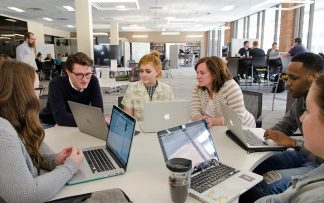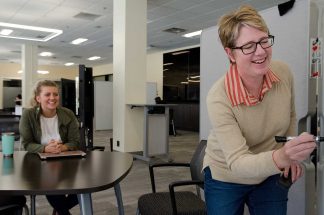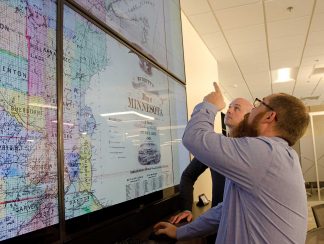
Professor Kate Derickson (fourth from left), Associate Professor in the Department of Geography, Environment & Society in the College of Liberal Arts, answers questions from students in her undergraduate geography class, Cities, Citizens, and Communications. The class emphasized group work and collaborated closely with the Mapping Prejudice Project at the Libraries.
White boards flank the tables where University of Minnesota researchers gather in conversation with experts from the Libraries. Several research teams are present, each group having quickly and easily assembled its own custom work space. Chairs, tables, and white boards have wheels that can be locked and unlocked, moved where they are needed.
A Research Sprints session like this one brings teams of researchers and librarians together to work intensely and collaboratively, over a period of several days, to move a project forward. The participants take notes, ask questions, and connect their laptops to larger screens in the room to share information with their group as they access a website or database. Librarians stay with an assigned group, or else move among them when their expertise is required for other projects.
The new Wilson Research Collaboration Studio, which opened its doors for the first time in July 2017, is just the right place for programs like this one to flourish.
“Every aspect of the design is meant to encourage people to talk to each other, to work together — not to be isolated individuals in a quiet space, but rather have collaborative conversations around research,” says Benjamin Wiggins, Program Director of the Digital Arts, Sciences, & Humanities (DASH) program and co-chair of the Libraries’ Research Sprints program.
Flexibility by design

Julia Van Etten uses a white board in the studio to illustrate a point for her marketing student Anne Schwappach.
Undergraduate student Anne Schwappach, enrolled at the Carlson School of Management, appreciates the room for its features, including “the whiteboards for brainstorming, the screens for sharing mockups, and the space for being able to easily communicate.”
Schwappach got the chance to experience the studio firsthand thanks to her professor Julia Van Etten, who was interested to see how the new space would work for class sessions that required extensive group work.
Van Etten’s first visit to the studio with her class featured an introduction to 15 specialized databases focused on branding, consumers, and market research.
“As they learned about the databases they worked on them here in their groups,” Van Etten says, adding that she and Business Librarian Caroline Lilyard could easily move around and answer students’ questions.
“Normally I’d say go look at the databases and bring it back to class, but it was so much more valuable to do it in real time,” Van Etten says. “A space like this breaks down barriers and you get to know your students better — being able to facilitate learning in a space like this is such a gift.”
Her students enjoyed working on their projects in the Research Collaboration Studio as much as Van Etten. “We had a project workshop day scheduled in class and I asked if they wanted to head back to the library and it was unanimous. They all did.”
Find study spaces
U of M students, staff, and faculty have a couple of options for finding the right spot to meet or study and making sure it’s available when they need it. Two excellent resources for locating and reserving rooms are the University’s Study Space Finder website and the Libraries’ Reserve a Space web page.
Study Space Finder is exactly what the name suggests: A website that helps identify different places on campus to study.
“The idea is that a student is walking through campus, they’re in front of a building they’ve never been to before, and they need a place to study. They can go to the site and it will show where they are on the map. They can check a building close to them, see if there are some nice study spaces inside, and find out what floors they are on,” said Kate Peterson, Undergraduate Services Librarian.
The site — studyspace.umn.edu — is mobile friendly. In the future, it will become a downloadable app for use on phones and devices. Reserve a Space can be found online at z.umn.edu/reserve. Six library buildings have group study rooms available for reservation. Technology-enabled spaces, media viewing rooms, and 1:Button Studios — the place to go for video production — can also be reserved using this system.
“Users should know that the system is popular, especially around finals,” said Emily Reimer, a Library Manager for Access and Information Services. “I encourage people who would like to make reservations to plan ahead!”
—Karen Carmody-McIntosh
A new home for Libraries programs and services
The studio functions as a home base for programs and services that support University research. Programs that operate in the studio include the Programming and Pizza series hosted by the University’s Digital Arts, Sciences, & Humanities (DASH) program. Graduate students can sign up to attend one of the monthly events in order to get hands-on help with technical projects like web design, scripting and programming, data analysis, and database development, to name a few.
The space is also being used to help University experts forge meaningful community partnerships. The Hennepin University Partnership initiative, for example, brings U of M faculty together with staff from across Hennepin County government. A recent event in the series focused on addressing racial disparities in the criminal justice system. The group conversations and brainstorming sessions that happen in the studio can serve as preparatory work for grants to sustain the collaboration.
“Libraries are a pillar of the community, whether you’re in an academic library or public library,” says Lacie McMillan, Library Assistant for Access & Information Services who works as support staff for the Wilson Studio. “It’s important for the community to know they are welcome here.”
Reflecting that ideal of communal space, the studio is open to all on a first-come, first-served basis. Some portions of the room can be reserved in advance by University faculty, staff, and students, including tables for group projects and a team meeting room. Another team room, the Business Research & Data Lab, is available for Carlson School of Management faculty and staff.
What about content?
While some Libraries spaces are undergoing big changes, the content and collections strategy hasn’t seen a radical shift. As always, librarians are dedicated to acquiring the vast array of materials needed for research, scholarship, and teaching. New materials, both print and electronic, are added to the collections throughout every year.
“Our investments have slightly shifted in terms of what we’ve traditionally purchased,” said Janet Bishop, Associate University Librarian for Content & Collections. “While we still purchase printed materials, our content comes in other ways too — such as datasets, streaming video, electronic journals, and electronic books. Roughly 85 percent of our content expenditures are for content that is in electronic format.”
All content purchases are considered carefully with the end user in mind. In practice, that requires assessing both cost and usage to make the best decisions possible.
In addition to purchasing new content, librarians also make informed decisions to manage existing content. Nearly every library building on campus is at capacity, which means there would be no room for new print materials or new study spaces if existing content weren’t diligently managed. For some items, that means a change of residence — moving from the stacks in a campus library building to the shelves of a storage facility.
“We pay a lot of attention to usage statistics when we move print materials to remote storage,” said Bishop. “It is not done without thought and a considerable amount of analytics.”
Items that live in the remote storage facility can still be accessed and retrieved; however, the process takes longer than simply grabbing a book off the shelf — a few business days is typical. Waiting times aren’t always required, since some materials in storage are also available electronically and can be accessed immediately.
While the format of some content is different than in decades past, the goal of the Libraries is not fundamentally new. Academic librarians have been striving for a long time to make content accessible for researchers, teachers, and students alike. That goal isn’t going away.
—Karen Carmody-McIntosh
All part of a larger plan

Ryan Mattke, Map & Geospatial Information Librarian, points out details on an 1871 map of Minnesota to Benjamin Wiggins, Program Director of the Digital Arts, Sciences, & Humanities (DASH) program.
Since Wilson Library opened in 1968, collections have grown to overtake spaces that were originally set aside for students, faculty, and community members to do research.
“We’ve gradually lost space for user seating and we’ve had a persistent demand from students for more spaces and for different kinds of spaces, in particular group study and project team rooms,” says Claire Stewart, Associate University Librarian for Research & Learning.
User demand is an important factor, but certainly not the only consideration when it comes to making significant changes. The decision to move a collection is never something librarians take lightly. Before choosing the location of the Research Collaboration Studio, the Libraries conducted studies on collections use. Based on the data, compiled over three years, “it was pretty clear that if we were looking for somewhere to create a highly interactive collaborative space, this would be a good candidate,” says Stewart.
The Research Collaboration Studio is just the beginning, a preliminary phase in a carefully deliberated set of plans to improve user experience at Wilson Library. A longer-range plan is renovation of the building.
Although the renovation plans are not yet finalized, likely changes include expanding the SMART Learning Commons, creating havens for quiet study in addition to the louder spaces required for team collaboration, and addressing the need for technology-enriched spaces on campus.
When Stewart discusses the upcoming changes, she emphasizes the Libraries partnership with the Disability Resource Center.
“We take to heart what Scott Marshall and Donna [Johnson] who is the director say, ‘The goal should be accessibility not accommodation.’”
What that means, practically speaking, is that new spaces are being planned with access in mind and project planners are thinking through every decision from the design of doorways to the installation of lighting and the types of chairs being purchased to ensure that essential services are more accessible for the community of users who rely on Wilson Library.
“There’s a wonderful opportunity with Wilson — such a large and important space — to really do better than we have,” says Stewart. “I’m excited about that opportunity.”
Unleash your creativity at the Libraries
The Libraries has added new spaces for students to create and learn without fear of failure. At the Makerspace in the Bio-Medical Library and the Breakerspace in Walter Library, students can get hands-on experience with machines and technologies they might not have used before.
Knowledgeable staff and volunteers guide students as they design and print small items with a 3D printer, create detailed stickers with a vinyl cutter, learn to use a sewing machine, program small electronic devices, or interact with virtual reality for the first time.
Design thinking — specifically the process of creating rapid prototypes to test how well a product or idea will work — is central to the Makerspace/Breakerspace experience. Within this framework, a failure isn’t the end of the line; instead it’s an integral part of process improvement. Students, regardless of their academic discipline, can benefit from this type of hands-on learning and prototyping.
For students and faculty interested in creating a short video, the 1:Button Studios are the place to go. These video production studios are currently available at Walter Library, Magrath Library, and the Bio-Medical Library. A fourth 1:Button Studio, currently located in Rarig Center, will move to Wilson Library.
A data visualization studio is also in the works at the Bio-Medical Library. The Libraries already provides access to data visualization programs — which can convert datasets into charts, graphs, timelines, interactive maps, and other sophisticated visual representations to help researchers communicate their findings. The new studio space will provide a place for Libraries experts to guide students and researchers as they learn to tell compelling stories with their data.
“We’ve added these spaces because they each represent an emerging literacy that is going to help our students be more effective and successful in their future careers,” said Jonathan Koffel, Emerging Technology and Innovation Strategist for the Libraries. “These are toolsets that are increasingly being applied across academic disciplines and occupations.”
The Libraries, as a common good for the U of M campus, is the right place to make these technologies available for all students. “A lot these ideas tend to be emphasized in certain disciplines only — in health sciences, mechanical engineering, design, or computer science,” said Elisandro “Alex” Cabada, Engineering and Innovation Librarian. “Many students are left behind. We want to make sure we have a space that is discipline-neutral where all students can walk in and be exposed to emerging technologies and design thinking.”
—Karen Carmody-McIntosh




